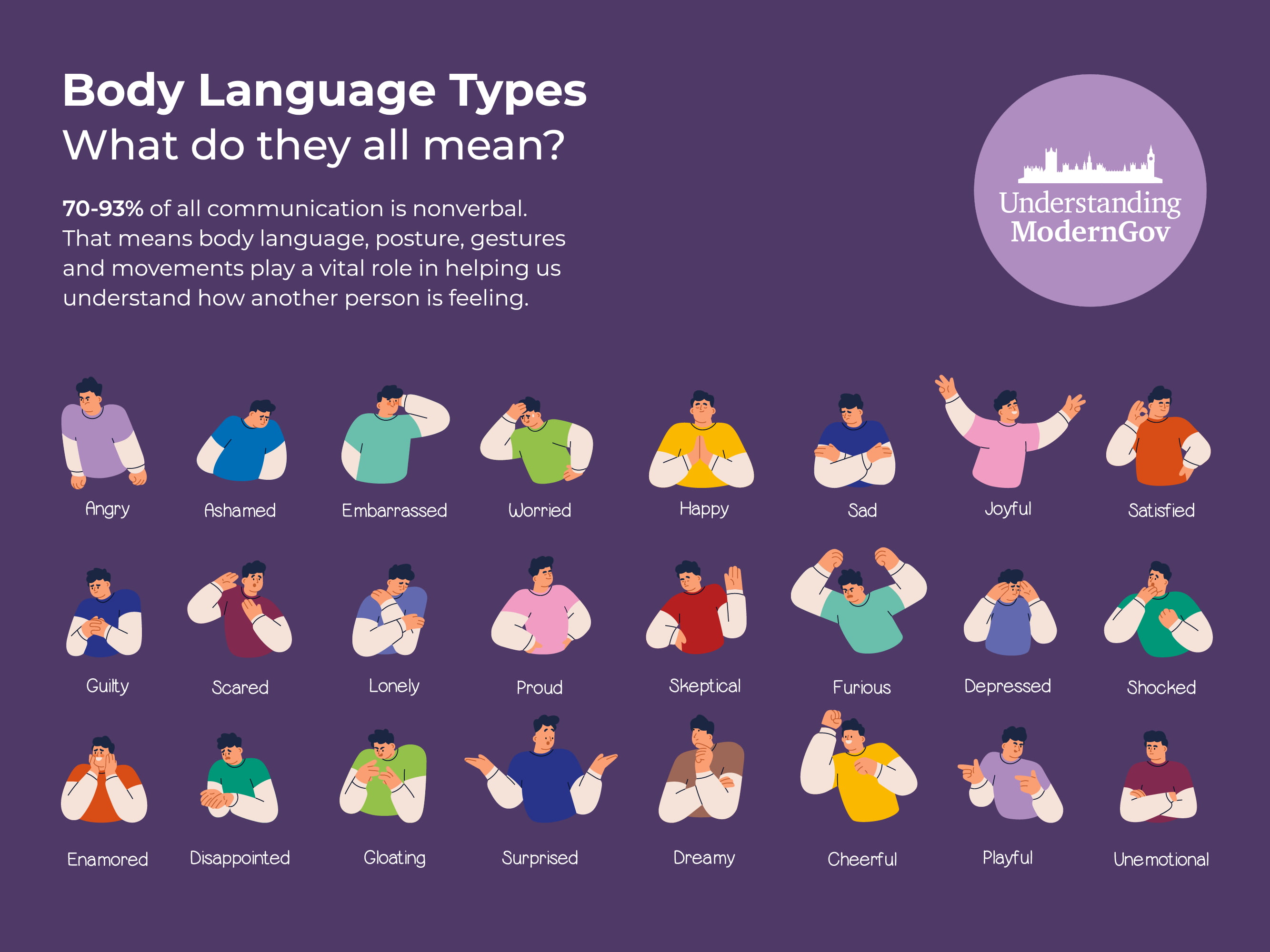What is the Importance of Body Language in Communication?
 Chloe Martin
·
7 minute read
Chloe Martin
·
7 minute read
(Updated April 2024)
How often do you think about your body language on the day-to-day?
Most of the time, our body language is unconscious. We move naturally in certain ways without even noticing.
This means we're sending signals all the time, even if we're unaware of them.
By being able to understand our own and other people's body language signals, we can improve our communication on a wide scale.
In this post, we'll cover exactly what body language is, why it's important, how you can use your body language to your advantage and how to improve your body language for the workplace.
Contents:
- What is Body Language?
- Why is Body Language Important in Communication?
- Importance of Using Body Language Cues in the Workplace
- How to Improve Your Body Language for the Workplace | 5 Ways
- The Top 5 Advantages of Using Body Language
- Key Takeaways
- Download Our Free Communication Skills Handbook
What is Body Language?
Body language is nonverbal communication that includes our posture, hand gestures and body movements.
We communicate through body language frequently in our daily lives, usually subconsciously.
It was Albert Mehrabian who theorised that nonverbal communication, such as tone of voice and facial expression collectively, make up 93% of all communication. Meaning spoken words make up just 7%!
This means that although we use our verbal communication (words) to share and speak our opinions, our body language will often communicate even more to our audience than we realise.
Some expert psychologists even say that body language can "reveal one's true feelings."
Body language is vital when we're public speaking or presenting to a small or wide audience, here's why.
Related: Why is Nonverbal Communication Important in the Workplace?
What is the Role of Body Language in Communication?
Body language enhances and amplifies the verbal message being portrayed through hand signals, gestures and postures. It helps us to convey emotions and intentions that may not be adequately expressed through words alone.
For example, a person shaking their head can convey disapproval, while someone nodding their head can convey understanding. This is just two very simple examples. Think of body language as an added bonus to any verbal conversation.
Why is Body Language Important in Communication?
Body language allows us to decode what a person is truly thinking or feeling without solely relying on their tone of voice and speech alone. It acts as an additional insight into unspoken emotions which can be crucial in the workplace.
We can use body language to give our words more impact and communicate more effectively.
Think about this example:
A speaker who gives off negative body language signals during their speech (turning their back to the audience or standing slouched), will be less likely to engage their audience and encourage them to listen to what they have to say.
This might sound harsh, but this is just how our human brains think.
Not only is this speaker losing the interest of their audience, but they’re also steering away the audience’s attention from the topic – no matter how important it is. No one wants this to happen.
3 Main Reasons Why Body Language is Important:
1. Understand the Feelings of Others
Being able to read body language means you can understand how another person is truly feeling using unspoken words and reactions.
Some body language types can be difficult to spot as they can happen fast, so you need to give your full attention to keep up and stay on the ball.
Read about common types of body language in communication so you can read anyone’s body language.
2. Show You’re Truly Engaged
Want to show someone you’re truly engaged in their conversation without actually saying it?
Use your body language.
If you’re speaking one-on-one with someone, open up your body language using good posture, maintaining eye contact, open hand gestures if having a discussion and a smile.
This means no crossed arms, hands on hips, harsh hand gestures or avoiding eye contact! Using disengaged body language might appear that you're uninterested in what they have to say - even if you're not.
Thinking about your body language when you’re actively listening will help you bond and develop relationships with anyone you speak to.
3. Demonstrate Your Confidence
Not everyone feels confident, especially if you feel uncomfortable under pressure or in front of groups of people.
But even the most visually confident people in the world have days where they don’t feel confident but still look it.
So how do they do it?
Using body language.
If you display confident body language, your audience is more likely to believe in your words and follow your lead.
Is Body Language More Impactful Than Words?
"Actions speak louder than words."
You've probably come across that saying once or twice before. But is body language alone more powerful than words?
We believe that both verbal and nonverbal communication are equally important and they work together to create a powerful impact. When used effectively, they can amplify the overall message, create a lasting impression on the listener and make or break an interaction.
Importance of Using Body Language Cues in the Workplace
Body language plays a big part in the workplace. Just because you’re not singing on stage or a football manager answering questions, doesn’t mean the same body language principles don’t apply to you in the workplace.
If you want to show you're a team player and that you truly care about the organisation and your colleagues, body language is your answer.
Body language in the workplace can help you show your enthusiasm for projects, your team and their successes or even your friendliness with new team members.
Using body language will help you find it easier to have conversations with colleagues and team members and achieve what you set out to in the workplace.
By not using nonverbal cues in the workplace, you might be misunderstood and leave others confused about your true thoughts on their conversation or even them as a person.
If you stare at someone and subconsciously grind your teeth, others are going to notice and become defensive. We advise you not to do this!
Further reading:
5 Body Language Tips for More Effective Communication in the Workplace
1. Move slowly
If you've ever watched a presentation where the speaker rushes their words, uses quick hand gestures and can't stand in one place, you'll know about this.
Moving quickly with a sense of urgency shows you're uncomfortable in the situation and can also make your audience feel the same.
Although you might be feeling uncomfortable, you may not want your audience to know.
By slowing down your body movements, you'll become more relaxed and confident in your words - and your audience will too!
2. Ask for Feedback From Your Peers
Try to be aware of the impact your body language is having during different interactions throughout the day. It might even be worth asking for feedback from those you’ve spoken to really understand how your body language comes across to others.
3. Adopt an Open Posture
What's the difference between an open and closed posture?
-
An open posture is a relaxed individual who uses open body language, such as facing the person or placing hands apart to appear approachable and receptive.
-
A closed posture is when a person crosses their arms or faces away from a person while they're talking. This shows defensiveness and disinterest in the person or the conversation.
By using an open posture, you can build a connection more easily
Bonus Tip: If you find it difficult to remember to use an open posture, give mirroring techniques a try. This is when you pay attention to the body language of others and mirror it subtly - reflecting their expressions or body positions. This doesn't mean mimicking their every move but doing so subtly to create a rapport with that person.
4. Mirror Facial Expressions
Facial expressions are universal. A smile can say so much without uttering a single word.
So whether you're speaking to a friend who's going through a hard time or you're in an important meeting where big decisions need to be made, try to mirror the facial expressions of those around you. This is a great way to show friendliness and openness and makes the speaker feel that they've been heard.
For example, if a friend comes to you with a personal issue they've been struggling with, they're looking for empathy and understanding, not anger or extreme happiness. By mirroring facial expressions in situations like these, you can validate their feelings and show they're not alone in this issue they're going through.
5. Attend a Confidence and Assertiveness Course
If you want to make a positive impact at work or with your colleagues, start by understanding how you are perceived in certain situations. This will help you get the results you're looking for no matter the context.
Our Confident Communication and Assertiveness course is led by Communications Coach and expect, Anne Walsh, who can help you enhance your communication through body language tips and truly understanding your communication style.
Want a taste of what to expect? Access our free taster session with Anne to discover a taste of what you can learn on one of our Confidence and Resilience training courses.
Mastering positive body language isn’t something that can be done overnight - it takes time to naturally be open, confident and engaged.
But work at it and you’ll find yourself doing a little bit better at poker the next time you play.
The Top 5 Advantages of Using Body Language
Body language can be utilised in various ways to effectively get your message across and achieve your desired outcome. Here are the five most effective ways of using body language to enhance your communication in the workplace:
1. Complements Your Message
Nonverbal cues serve to amplify and reinforce the message conveyed through spoken words. For instance, in a workplace setting, a manager might express appreciation for an employee's excellent work by offering a congratulatory pat on the back.
2. Emphasises Your Key Points
This involves combining nonverbal cues with specific words or phrases to underscore or accentuate the significance of your verbal communication.
For instance, if someone insists on "getting it done now" while slamming their hand on the table, they are highlighting the urgency and significance of their message. However, this action could also be perceived as aggressive, depending on the tone and manner in which it is delivered.
3. Substitutes Verbal Communication
Nonverbal signals have the power to replace verbal communication altogether. A simple nod or shake of the head can convey a clear "yes" or "no", while a shrug of the shoulders indicates uncertainty. And when someone asks for directions to the bathroom, a friendly point and smile can speak volumes without saying a word.
4. Reinforces Your Message
Nonverbal cues have the power to strengthen the message you convey verbally. For instance, when you verbally direct someone by saying "The train station is on the right" and simultaneously gesture with your arm in that direction, you are reinforcing your instruction and providing clear guidance to the listener on where they need to go.
5. Saves Time
By combining verbal cues with nonverbal gestures, you can convey your message swiftly and efficiently, ultimately saving precious time for both yourself and your audience.
Key Takeaways
- Body language means nonverbal communication such as eye contact, hand movements and gestures.
- Body language is an essential form of communication because it gives us insights into how a person is really feeling and thinking.
- Using nonverbal communication is important in the workplace as it offers an opportunity to show you're truly engaged in conversation, interested in what another person is saying and demonstrate confidence.
- To become a more effective communicator, start improving how you use body language in the workplace by attending one of our courses, adopting an open posture (no crossed arms and slouching) and asking for feedback from colleagues to see which areas you need to focus on.
- The advantages of non verbal communication include: it complements your message, helps emphasise key points, saves time, can replace verbal communication, and reinforces your message.
Improve Your Daily Interactions at Work with our Free Communication Skills Handbook
Body language is just a small part of becoming a fantastic communicator. If you’re trying to improve your verbal communication skills or you’d like to be a more engaging public speaker, then download our helpful guide today.
Click the 'Download the Guide' button below to get started.
2+ years in SEO and content marketing. Striving to help public sector professionals develop their skills and learn something new through high-quality content.









